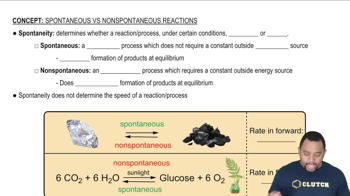Here are the essential concepts you must grasp in order to answer the question correctly.
Gibbs Free Energy (ΔG°)
Gibbs Free Energy (ΔG°) is a thermodynamic potential that measures the maximum reversible work obtainable from a thermodynamic process at constant temperature and pressure. A negative ΔG° indicates that a reaction is spontaneous, while a positive ΔG° suggests non-spontaneity. The value of ΔG° can be calculated using standard enthalpy and entropy changes, providing insight into the favorability of a reaction.
Recommended video:
Gibbs Free Energy of Reactions
Equilibrium Constant (Kp)
The equilibrium constant (Kp) is a dimensionless value that expresses the ratio of the concentrations of products to reactants at equilibrium for a given reaction, raised to the power of their stoichiometric coefficients. For gaseous reactions, Kp is calculated using partial pressures. The relationship between ΔG° and Kp is given by the equation ΔG° = -RT ln(Kp), linking thermodynamics with chemical equilibrium.
Recommended video:
Equilibrium Constant Expressions
Spontaneity of Reactions
The spontaneity of a reaction refers to its ability to proceed without external intervention. It is determined by the sign of ΔG°; if ΔG° is negative, the reaction is spontaneous under standard conditions. Factors such as temperature, pressure, and concentration can influence spontaneity, and understanding these factors is crucial for predicting the behavior of chemical reactions in various environments.
Recommended video:
 Verified step by step guidance
Verified step by step guidance


